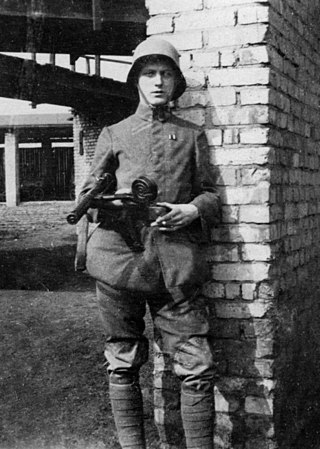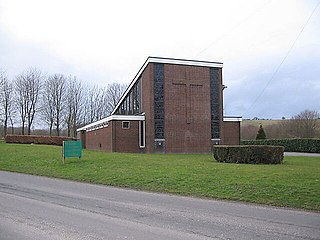The Infantry of the British Army comprises 49 infantry battalions, from 19 regiments. Of these, 33 battalions are part of the Regular army and the remaining 16 a part of the Army Reserve. The British Army's Infantry takes on a variety of roles, including armoured, mechanised, air assault and light.

Brigade of Gurkhas is the collective name which refers to all the units in the British Army that are composed of Nepalese Gurkha soldiers. The brigade draws its heritage from Gurkha units that originally served in the British Indian Army prior to Indian independence, and prior to that served for the East India Company. The brigade includes infantry, engineering, signal, logistic and training and support units. They are known for their khukuri, a distinctive heavy knife with a curved blade, and have a reputation for being fierce and brave soldiers.

The Royal Military Academy Sandhurst, commonly known simply as Sandhurst, is one of several military academies of the United Kingdom and is the British Army's initial officer training centre. It is located in the town of Sandhurst, Berkshire, though its ceremonial entrance is in Camberley, Surrey, southwest of London. The academy's stated aim is to be "the national centre of excellence for leadership". All British Army officers, including late-entry officers who were previously Warrant Officers, as well as other men and women from overseas, are trained at the academy. Sandhurst is the British Army equivalent of the Britannia Royal Naval College and the Royal Air Force College Cranwell.

A drill instructor is a non-commissioned officer in the armed forces, fire department, or police forces with specific duties that vary by country. Foot drill, military step, and marching are typically taught by drill instructors.

Stormtroopers were specialist infantry soldiers of the German Army. In the last years of World War I, Stoßtruppen were trained to use infiltration tactics – part of the Germans' improved method of attack on enemy trenches. The German Empire entered the war certain that the conflict would be won in the course of great military campaigns, thus relegating results obtained during individual clashes to the background; consequently the best officers, concentrated in the German General Staff, placed their attention on maneuver warfare and the rational exploitation of railways, rather than concentrating on the conduct of battles: this attitude gave a direct contribution to operational victories of Germany in Russia, Romania, Serbia and Italy, but it resulted in failure in the West. Thus the German officers on the Western Front found themselves in need of resolving the static situation caused by trench warfare on the battlefield.

16 Air Assault Brigade Combat Team, from 1999 to 2021 16 Air Assault Brigade, is a formation of the British Army based in Colchester in the county of Essex. It is the Army's rapid response airborne formation and is the only brigade in the British Army focused on delivering air assault operations.

The United States Army Airborne School—widely known as Jump School—conducts the basic paratrooper training for the United States Armed Forces. It is operated by the 1st Battalion (Airborne), 507th Infantry, United States Army Infantry School, Fort Moore, Georgia. The Airborne School conducts the Basic Airborne Course, which is open to troops from all branches of the United States Department of Defense, Reserve Officer Training Corps, and allied military personnel.

The Naval Aviation Warfighting Development Center was formerly known as the Naval Strike and Air Warfare Center at Naval Air Station Fallon located in the city of Fallon in western Nevada. It is the center of excellence for naval aviation training and tactics development. NAWDC provides service to aircrews, squadrons and air wings throughout the United States Navy through flight training, academic instructional classes, and direct operational and intelligence support. The name was changed from NSAWC to NAWDC in June 2015 to align with the naming convention of the Navy's other Warfighting Development Centers (including Naval Surface and Mine Warfighting Development Center, Naval Information Warfighting Development Center, and the Undersea Warfighting Development Center.
Selection and training in the British Army is the process by which candidates for service are identified, inducted and brought onto the trained strength. The process is the responsibility of the Home Command.

The Primary Reserve of the Canadian Armed Forces is the first and largest of the four sub-components of the Canadian Armed Forces reserves, followed by the Supplementary Reserve, the Cadet Organizations Administration and Training Service and the Canadian Rangers.
Ghatak Platoons are special operations capable reconnaissance platoons present in every infantry battalion of the Indian Army. Ghatak is a Sanskrit word meaning "killer" or "lethal". Their name was given to them by General Bipin Chandra Joshi. They act as shock troops and spearhead assaults ahead of the battalion.

The 3rd Battalion, Parachute Regiment, is a battalion sized formation of the British Army's Parachute Regiment and is a subordinate unit within 16 Air Assault Brigade.

Major General David Tennant Cowan,, also known as "Punch" Cowan, was an officer in the British Army and British Indian Army during the First and Second World Wars. He led the 17th Indian Infantry Division during almost the entire Burma campaign.

1 South African Infantry Battalion is a mechanized infantry unit of the South African Army.

4 South African Infantry Battalion is a motorised infantry unit of the South African Army.

8 South African Infantry Battalion is a mechanized infantry unit of the South African Army. The battalion is equipped with Ratel Infantry Fighting Vehicles (IFV) used for fast transport and combat mobility across rough ground. Support weapons for mechanized infantry are also provided with motorized transport, or are built directly into these IFVs, in order to keep pace with the IFVs in combat. The battalion was raised at Upington in the Northern Cape in 1973 as part of the South African Infantry Corps, and since the change in structure, has been assigned to the Infantry Formation.
Waterloo Lines is a British Army barracks on Imber Road in Warminster, Wiltshire, England. It is currently home to a number of Army specialist training schools and a sizeable portion of the Headquarters Field Army.
Brigadier Edirimuni Tennison De Zoysa Abeysekara was a Sri Lankan military leader, who served as the Chief of Staff of the Sri Lanka Army.

Warminster Garrison is a military garrison of the British Army, on the edge of Salisbury Plain in Wiltshire, England.
The Army Recruiting and Initial Training Command (ARITC) is a two-star command of the British Army and "is responsible for all recruiting, selection, and basic training of soldiers and the recruitment and selection of officers".















